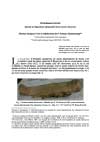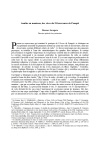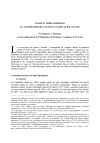Florence Saragoza
« Doublement Ă©ternel. Quand les Egyptiens inhumaient leurs morts deux fois »
ENiM 7, 2014, p. 61-78.
 Le musée départemental des Antiquités à Rouen conserve une momie d’enfant (âgé de 2-3 ans) découverte en 1889 à Akhmîm par G. le Breton alors directeur et conservateur du musée. Si l’apparence extérieure de cette momie est tout à fait classique, l’examen radiographique indique que la tête est en fait maintenue au corps par une tige de palmier (gerid). D’autres momies présentent une telle particularité interprétée le plus souvent comme le témoignage d’une momification de piètre qualité. Il apparaît que la dislocation de la tête ne peut raisonnablement se produire lors des opérations de momification, mais semble plus logique si elle intervient longtemps après la mort. Dès lors, la tige de palmier sert à assurer au défunt son unité corporelle, un des principaux concepts de la pensée funéraire égyptienne. Le gerid témoigne d’un type d'intervention après inhumation différent de ceux mis en évidence dans la Nécropolis d’Alexandrie. Cela signifie également que l’emmaillotage actuellement visible n'est pas l’original puisque la momie a dû être bandelettée à nouveau après la resolidarisation de la tête au corps.
Le musée départemental des Antiquités à Rouen conserve une momie d’enfant (âgé de 2-3 ans) découverte en 1889 à Akhmîm par G. le Breton alors directeur et conservateur du musée. Si l’apparence extérieure de cette momie est tout à fait classique, l’examen radiographique indique que la tête est en fait maintenue au corps par une tige de palmier (gerid). D’autres momies présentent une telle particularité interprétée le plus souvent comme le témoignage d’une momification de piètre qualité. Il apparaît que la dislocation de la tête ne peut raisonnablement se produire lors des opérations de momification, mais semble plus logique si elle intervient longtemps après la mort. Dès lors, la tige de palmier sert à assurer au défunt son unité corporelle, un des principaux concepts de la pensée funéraire égyptienne. Le gerid témoigne d’un type d'intervention après inhumation différent de ceux mis en évidence dans la Nécropolis d’Alexandrie. Cela signifie également que l’emmaillotage actuellement visible n'est pas l’original puisque la momie a dû être bandelettée à nouveau après la resolidarisation de la tête au corps.
 In the musée des Antiquités in Rouen, one can see a child mummy (2-3 years of age) discovered in 1889 in Akhmim by G. Le Breton who was at that time the director of the museum. It has the classical external appearance of a mummy, but x-Rays examination shows that the head is joined to the body with a piece of palm stalck (gerid). Several mummies present such a characteristic which is very often interpreted in terms of poor quality mumification. But it appears that such a fracture cannot occur during the mumification process, but, on the contrary, can occur a long-time after death. The fracture was repaired using a stick to guarantee the body unity of the deceased, one of the most important concepts of the Egyptian Afterlife. This gerid is a testimony of a post-burial intervention different from what can be done in the Necropolis of Alexandria. It also means that the mummy bandaging is not the original one as the mummy needed to be wrapped an other time after the head was replaced onto the body.
In the musée des Antiquités in Rouen, one can see a child mummy (2-3 years of age) discovered in 1889 in Akhmim by G. Le Breton who was at that time the director of the museum. It has the classical external appearance of a mummy, but x-Rays examination shows that the head is joined to the body with a piece of palm stalck (gerid). Several mummies present such a characteristic which is very often interpreted in terms of poor quality mumification. But it appears that such a fracture cannot occur during the mumification process, but, on the contrary, can occur a long-time after death. The fracture was repaired using a stick to guarantee the body unity of the deceased, one of the most important concepts of the Egyptian Afterlife. This gerid is a testimony of a post-burial intervention different from what can be done in the Necropolis of Alexandria. It also means that the mummy bandaging is not the original one as the mummy needed to be wrapped an other time after the head was replaced onto the body.
 Consulter cet article (55858) -
Consulter cet article (55858) -  Télécharger cet article au format pdf (28380)
Télécharger cet article au format pdf (28380)
« Anubis au manteau, des rives du Nil aux murs de PompĂ©i »
ENiM 12, 2019, p. 201-232.
 L’Anubophore compte parmi les figures isiaques bien attestées par les sources textuelles et matérielles d’époque romaine. Au sein des processions, il incarne par ses attributs – un masque, un vêtement et une gestuelle particuliers – le dieu Anubis. Si ce personnage semble trouver son origine dans une figure de prêtre de l’Égypte du Ier millénaire, son transfert iconographique vers l’Occident s’est accompagné d’une transformation du sens et de la valeur de cette image.
L’Anubophore compte parmi les figures isiaques bien attestées par les sources textuelles et matérielles d’époque romaine. Au sein des processions, il incarne par ses attributs – un masque, un vêtement et une gestuelle particuliers – le dieu Anubis. Si ce personnage semble trouver son origine dans une figure de prêtre de l’Égypte du Ier millénaire, son transfert iconographique vers l’Occident s’est accompagné d’une transformation du sens et de la valeur de cette image.
 The Anubophorus is among the isiac figures best attested in textual and material sources of Roman times. Within the festival processions, he embodies through his attributes – particular mask, clothing and gestures – the god Anubis. If this character seems to have its origin from the figure of an egyptian priest of the 1st millennium, the meaning and value of this image have changed during its iconographic transfer to the West.
The Anubophorus is among the isiac figures best attested in textual and material sources of Roman times. Within the festival processions, he embodies through his attributes – particular mask, clothing and gestures – the god Anubis. If this character seems to have its origin from the figure of an egyptian priest of the 1st millennium, the meaning and value of this image have changed during its iconographic transfer to the West.
 Consulter cet article (46426) -
Consulter cet article (46426) -  Télécharger cet article au format pdf (24946)
Télécharger cet article au format pdf (24946)
« Arsenic et vieilles bandelettes. Les ensembles funĂ©raires du musĂ©e Crozatier au Puy-en-Velay »
ENiM 15, 2022, p. 1-34.
 Les travaux de rénovation du musée Crozatier ont fourni l’occasion propice à l’étude de deux ensembles funéraires égyptiens rapportés en France au XIXe siècle. Cette étude pluridisciplinaire, qui a réuni l’équipe du musée, V. Desclaux, des restauratrices d’œuvres d’art, l’équipe du service d’imagerie médicale de l’hôpital Emile-Roux au Puy-en-Velay et la responsable du groupe datation du C2RMF, offre ainsi la première édition des textes des cercueils ainsi qu’un nouvel exemple de momie (Djedimenet) contenant une figurine de terre cuite de forme anthropomorphe, permettant ainsi d’enrichir un corpus en cours de constitution. L’analyse de la momie renfermée dans le cercueil de la dame Henout a quant à elle révélé que cette momie n’était pas celle de dame Henout, puisqu’il s’agit… d’un homme !
Les travaux de rénovation du musée Crozatier ont fourni l’occasion propice à l’étude de deux ensembles funéraires égyptiens rapportés en France au XIXe siècle. Cette étude pluridisciplinaire, qui a réuni l’équipe du musée, V. Desclaux, des restauratrices d’œuvres d’art, l’équipe du service d’imagerie médicale de l’hôpital Emile-Roux au Puy-en-Velay et la responsable du groupe datation du C2RMF, offre ainsi la première édition des textes des cercueils ainsi qu’un nouvel exemple de momie (Djedimenet) contenant une figurine de terre cuite de forme anthropomorphe, permettant ainsi d’enrichir un corpus en cours de constitution. L’analyse de la momie renfermée dans le cercueil de la dame Henout a quant à elle révélé que cette momie n’était pas celle de dame Henout, puisqu’il s’agit… d’un homme !
 Renovation works on the Crozatier museum provided the perfect opportunity to study two Egyptian wooden coffins including human mummies which were brought to France in the 19th century. This multidisciplinary study, which brought together the museum team, V. Desclaux from the BNF, conservators, the team of the medical imaging department at Emile-Roux hospital in Le Puy-en-Velay and the person in charge of C14 dating for the C2RMF in Paris, offers the first edition of the funerary texts of the two coffins and of Djedimenet's painted cartonnage of as well as a new example of a mummy containing an anthropomorphic terracotta figurine. Analysis of the mummy enclosed in the lady’s coffin revealed that this mummy was not that of Dame Henout[nefer?], since (s)he is ...a man !
Renovation works on the Crozatier museum provided the perfect opportunity to study two Egyptian wooden coffins including human mummies which were brought to France in the 19th century. This multidisciplinary study, which brought together the museum team, V. Desclaux from the BNF, conservators, the team of the medical imaging department at Emile-Roux hospital in Le Puy-en-Velay and the person in charge of C14 dating for the C2RMF in Paris, offers the first edition of the funerary texts of the two coffins and of Djedimenet's painted cartonnage of as well as a new example of a mummy containing an anthropomorphic terracotta figurine. Analysis of the mummy enclosed in the lady’s coffin revealed that this mummy was not that of Dame Henout[nefer?], since (s)he is ...a man !
 Consulter cet article (42175) -
Consulter cet article (42175) -  Télécharger cet article au format pdf (19948)
Télécharger cet article au format pdf (19948)
ENiM 18 - 2025
8 article(s) - 8 octobre 2025.
ENiM 1 à 18 (2008-2025) : 227 articles
5 211 544 téléchargements
10 399 571 consulations.
Index des auteurs

Mots clés

Derniers articles : 
CENiM - Mise en ligne des volumes Ă©puisĂ©s : 
 Anne-Sophie von BOMHARD DĂ©cans Ă©gyptiens, CENiM 23, Montpellier, 2020 — (2020)
Anne-Sophie von BOMHARD DĂ©cans Ă©gyptiens, CENiM 23, Montpellier, 2020 — (2020) 
 Jean-Claude Grenier L'Osiris ANTINOOS, CENiM 1, Montpellier, 2008 — (26 dĂ©cembre 2008)
Jean-Claude Grenier L'Osiris ANTINOOS, CENiM 1, Montpellier, 2008 — (26 dĂ©cembre 2008) 
TDENiM - Mise en ligne des volumes Ă©puisĂ©s : 
 Twitter
Twitter 4163345 visites - 2262 visite(s) aujourd’hui - 130 connecté(s)
© ENiM - Une revue d’égyptologie sur internet
Équipe Égypte Nilotique et Méditerranéenne - UMR 5140 - « Archéologie des Sociétés Méditerranéennes » (Cnrs) - Université Paul Valéry - Montpellier III
























 Contact
Contact
 Abonnez-vous !
Abonnez-vous ! Équipe Égypte Nilotique et Méditerranéenne
Équipe Égypte Nilotique et Méditerranéenne UMR 5140 « Archéologie des Sociétés Méditerranéennes » (Cnrs)
UMR 5140 « Archéologie des Sociétés Méditerranéennes » (Cnrs) Université Paul Valéry - Montpellier III
Université Paul Valéry - Montpellier III